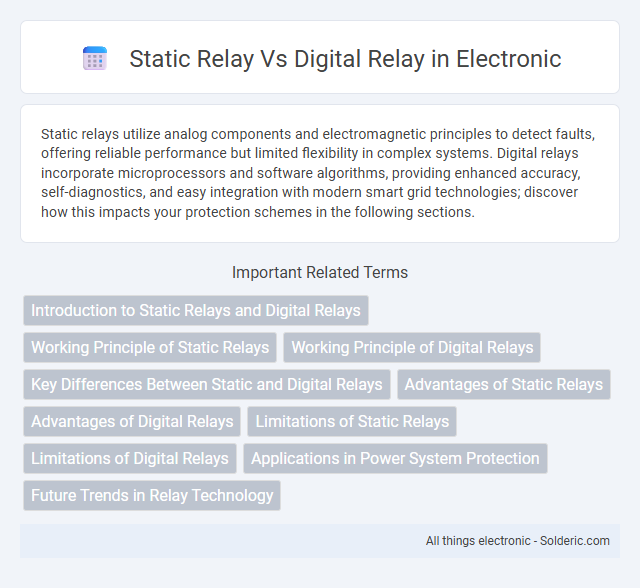Static relays utilize analog components and electromagnetic principles to detect faults, offering reliable performance but limited flexibility in complex systems. Digital relays incorporate microprocessors and software algorithms, providing enhanced accuracy, self-diagnostics, and easy integration with modern smart grid technologies; discover how this impacts your protection schemes in the following sections.
Comparison Table
| Feature | Static Relay | Digital Relay |
|---|---|---|
| Technology | Analog electronic components | Microprocessors and software-based |
| Accuracy | Moderate, limited by analog design | High precision with digital signal processing |
| Flexibility | Fixed settings, limited customization | Programmable and easily configurable |
| Functionality | Basic protective functions | Advanced protection, monitoring, and communication |
| Communication | No or minimal communication capabilities | Supports protocols like IEC 61850, Modbus |
| Maintenance | Requires manual calibration and testing | Remote diagnostics and easier updates |
| Cost | Lower initial cost | Higher upfront cost but cost-effective long-term |
| Reliability | Good reliability under stable conditions | High reliability with self-monitoring features |
Introduction to Static Relays and Digital Relays
Static relays utilize analog electronic components such as transistors and op-amps to perform protection functions, providing faster response times and improved reliability compared to traditional electromechanical relays. Digital relays, also known as numerical relays, employ microprocessors and software algorithms to monitor and analyze electrical parameters, enabling multifunctional protection, communication capabilities, and easy configuration. Both types of relays are integral in modern power system protection but differ significantly in technology, flexibility, and data processing abilities.
Working Principle of Static Relays
Static relays operate using electronic components such as transistors and diodes to process input signals without moving parts, relying on analog or digital circuits to detect faults by comparing input voltage or current against preset thresholds. In contrast, traditional electromechanical relays use electromagnetic coils and mechanical contacts to physically open or close circuits. The absence of mechanical parts in static relays enhances their speed, accuracy, and reliability in protective relay applications.
Working Principle of Digital Relays
Digital relays operate by converting analog signals from power systems into digital data through analog-to-digital converters, enabling microprocessors to analyze and process the information for precise fault detection and system protection. Unlike static relays that rely on discrete electronic components for specific functions, digital relays utilize software algorithms to perform complex calculations and adaptive control strategies. Your electrical protection system benefits from faster response times, increased accuracy, and enhanced communication capabilities inherent in digital relay technology.
Key Differences Between Static and Digital Relays
Static relays use analog components such as transistors and diodes to perform protection functions, relying on continuous electrical signals, while digital relays employ microprocessors and software algorithms for enhanced accuracy and flexibility. Digital relays provide advanced features like data recording, communication capabilities, and easier integration with modern grid systems compared to static relays. The transition to digital relays improves fault detection speed, reduces maintenance, and supports complex protection schemes not feasible with static relay technology.
Advantages of Static Relays
Static relays offer faster response times and higher reliability compared to electromechanical relays, making them ideal for protecting modern electrical systems. They have no moving parts, which reduces maintenance costs and increases operational lifespan, enhancing the overall stability of your power network. Their versatility allows for easy integration with digital control systems, improving protection accuracy and diagnostic capabilities.
Advantages of Digital Relays
Digital relays offer enhanced accuracy, faster fault detection, and improved reliability compared to static relays, enabling more precise protection for electrical systems. Their ability to integrate multiple protection functions and provide real-time monitoring enhances system efficiency and reduces downtime. Your power infrastructure benefits from advanced diagnostics and easier maintenance through digital relay technology.
Limitations of Static Relays
Static relays face limitations such as susceptibility to temperature variations and component aging, which can affect their accuracy and reliability. Unlike digital relays, they lack advanced self-diagnostic features and often require manual calibration, increasing maintenance efforts. Your protection system may benefit from digital relays that offer enhanced precision, adaptability, and communication capabilities.
Limitations of Digital Relays
Digital relays often face limitations such as vulnerability to electromagnetic interference, slower response times compared to static relays, and higher initial costs for installation and maintenance. They require complex software and skilled personnel for configuration and troubleshooting, which can increase operational challenges. Your power system's reliability may be impacted if these constraints are not properly managed.
Applications in Power System Protection
Static relays are primarily used in traditional power system protection due to their high reliability and simplicity in detecting fault conditions, making them suitable for basic overcurrent and voltage protection. Digital relays offer enhanced functionality with programmable settings, communication capabilities, and improved fault analysis, which makes them ideal for complex protection schemes such as distance protection, differential protection, and adaptive protection in modern smart grids. Your power system can achieve greater accuracy and faster response times by integrating digital relays into critical protection applications, ensuring improved system stability and fault management.
Future Trends in Relay Technology
Digital relays are rapidly becoming the standard due to their advanced features like precise fault detection, remote monitoring, and adaptability to smart grid integration. Static relays, while historically reliable for basic protection, lack the programmability and communication capabilities essential for modern power systems. Your future-proofing strategy should prioritize digital relay technology to leverage enhanced diagnostic tools and improved operational efficiency in evolving electrical networks.
Static relay vs digital relay Infographic

 solderic.com
solderic.com